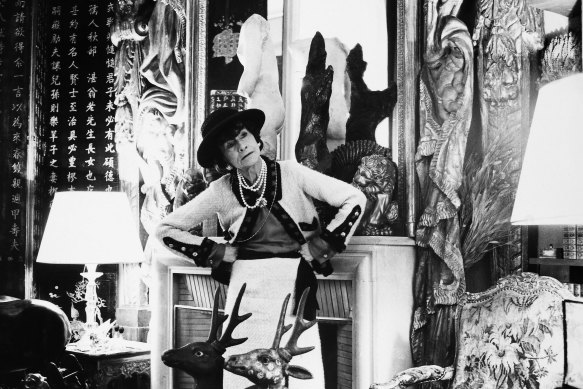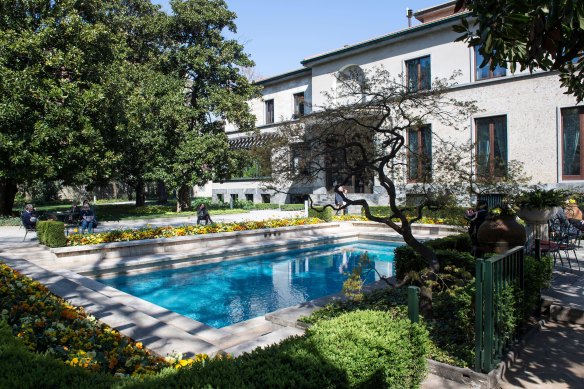Opinion
Snooping in famous dead people’s homes is one of my favourite things to do
Lee Tulloch
Travel columnistI’ve been watching the TV series The New Look (Apple TV) which is about the post-war fashion industry in 1940s Paris, when Christian Dior unveiled his “New Look”, a collection of voluminous dresses that caused a furore after the rationing of the war.

Coco Chanel in her suite at the Ritz Hotel, Paris, 1965.Credit: Alamy
Coco Chanel features in the series as an ally and rival of Dior, which also looks at both fashion designers’ conduct during the Nazi occupation. The sets are lavish and the fashions have been replicated in painstaking detail.
There are several scenes where Chanel (played by Juliette Binoche) is depicted in her apartment at 31, rue Cambon, which was above her atelier and boutique. It was the place she went to think. She lived around the corner in The Ritz. (You can rent her Ritz suite for a mere €40,000 a night.)
Chanel died in 1971 but the apartment was retained by the fashion house and restored in recent times by designer Jacques Grange. Karl Lagerfeld spent a lot of time there soaking up Chanel’s spirit and seeking inspiration, they say.
I visited the apartment many years ago. I remember the famous lacquer Coromandel screens in the salon, against which many photos of her were taken, and the suede couch that she sat on to receive visitors, which was slightly worn. Unfortunately, it appears the suede sofa has been replaced in the recent restoration.
I loved the fact that Coco’s sofa was worn – perhaps the result of many trysts with alluring men? Or simply the place where she read books? It’s the everyday things that I find touching in these rooms.
Snooping in famous dead people’s homes is one of my favourite things to do. I’m not so much interested in museums and palaces. I’d much rather visit a place that was a real home, one that has its living history preserved. A place with a human scale.
Europe is rich with house museums, many containing collections of the furniture and personal ephemera of the famous inhabitants, some that are true time capsules. I’ve been to Beatrix Potter’s house in the Lake District and Lord Leighton’s Moorish fantasy in London, and many travellers are familiar with Monet’s house in Giverny, Sigmund Freud’s house in Vienna, Victor Hugo’s apartment in Paris and my favourite, Mariano Fortuny’s palazzo in Venice.
The eccentric American art collector Peggy Guggenheim purchased the Palazzo Venier dei Leoni on the Grand Canal in Venice in 1949. The unfinished palace had been at one time the home of the decadent Marchesa Luis Casati, who would take her ocelots for a stroll outside the palazzo wearing nothing under her fur coat. The building now houses the Peggy Guggenheim collection, Venice’s second most-visited attraction.
Most of Peggy’s furniture is gone, but if you visit at quiet times, you can channel her spirit, through her taste in art. Perhaps it’s also because she’s interred in the garden, along with the ashes of her 14 beloved Lhasa Apsos dogs.
Probably the best-preserved home museum I’ve seen is the wonderful Villa Necchi Campiglio in Milan, a fine example of Rationalist architecture from the 1930s. I’d admired it as the location for the 2009 Italian film I Am Love which starred Tilda Swinton as a rich industrialist’s wife who swanned around her gorgeous villa in impeccable Jil Sander clothes.

Villa Necchi Campiglio, Milan, is one of the best-preserved home museums.Credit: Alamy
The house was designed by Piero Portaluppi for sewing machine tycoon Angelo Campiglio, his wife Gigina and her sister Nedda Necchi, who lived with them. The sprawling two-storey house set in gardens with Milan’s first private swimming pool remains almost exactly as the family left it.
It retains all the family’s furniture, including made-up beds and a dining table set for 12 for dinner, and an impressive art collection of significant works by early 20th-century artists such as Giorgio de Chirico.
The architectural details are sumptuous but what I loved most were the upstairs bedrooms and bathrooms, full of the family’s possessions, from floor-to ceiling wardrobes packed with neatly arranged clothing, furs and accessories, to vanity tables laid out with hairbrushes, face creams and perfume bottles.
One room is devoted to collections of all their bed and table linen and the maids’ and chauffeurs’ uniforms.
As voyeurism into the life of a wealthy and privileged 20th-century family it is first-rate. Talk about real-estate envy, I wanted to move right in.
Historical palaces like Versailles and European castles will always hold a certain fascination, but I prefer my museums to be more homely.
Sign up for the Traveller newsletter
The latest travel news, tips and inspiration delivered to your inbox. Sign up now.